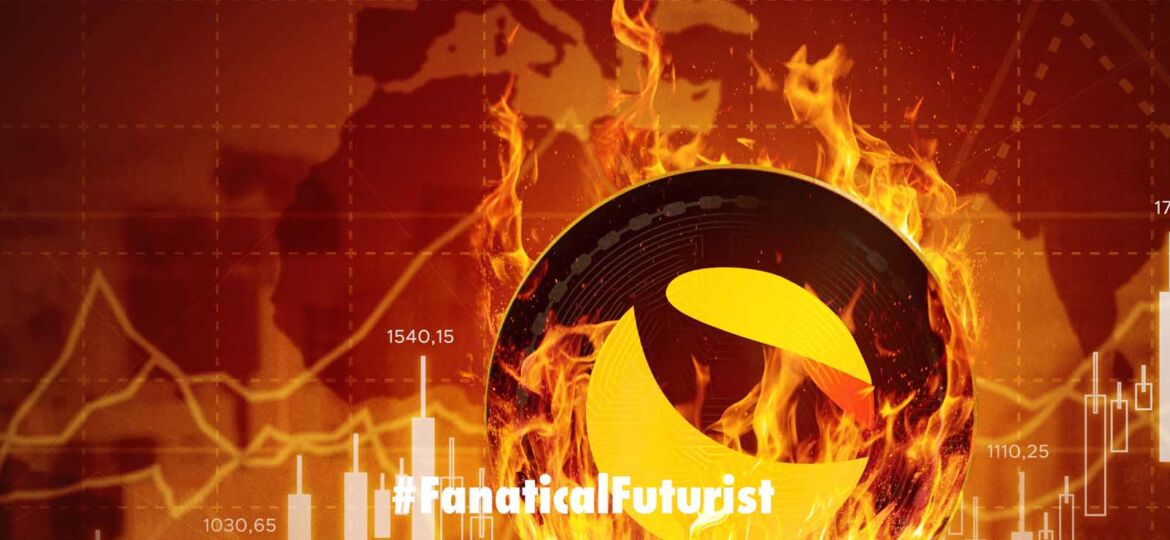
WHY THIS MATTERS IN BRIEF
Crypto currencies, essentially programmable money, don’t play by old world rules and it shows the stark divide between old money and “new” money.
 Love the Exponential Future? Join our XPotential Community, subscribe to the podcast, future proof yourself with courses from XPotential University, read about exponential tech and trends, connect, watch a keynote, or browse my blog.
Love the Exponential Future? Join our XPotential Community, subscribe to the podcast, future proof yourself with courses from XPotential University, read about exponential tech and trends, connect, watch a keynote, or browse my blog.
By now we’re getting used to the weirdness of cryptocurrencies, essentially “programmable money” that means, for example, governments now have the ability to expire your money with all the pros and cons that brings … However, taking odd to a new level owners of the cryptocurrency Luna who’ve been nursing enormous losses since the giant crypto crash earlier this year are now proposing an unorthodox solution to salvage their tanking investments: they’re volunteering to destroy their own coins.
When you think about it not only does it sound nuts, but it also highlights just how far apart the “new” world of cryptocurrencies are from “old world” money which you’d never even think of destroying.
The plan to partially deflate the supply of Luna coins to prop up the price seems so foolhardy even the token’s baffled creator who warned what little remains of their original capital would only go up in smoke.
“Why would you do this. Literally burning money,” tweeted Do Kwon, co-founder and CEO of Terraform Labs, on Saturday.
The South Korean presided over the single biggest value destruction the crypto market has seen to date when his Luna governance token collapsed after the algorithmic stablecoin it backed, TerraUSD, lost its fixed 1-to-1 exchange rate to the dollar.
The supply of Luna ballooned from an estimated 350 million to over 6.5 trillion, with its value plummeting to hundredths of a penny in the ensuing hyperinflationary cycle. Even an attempt to defend the TerraUSD peg by depleting billions in Bitcoin reserves proved in vain.
The ensuing chaos rocked the broader crypto market and forced collateralized stablecoin issuer Tether Holdings to assure investors it could meet redemptions thanks to its reserves of fiat-backed assets.
One Luna holder argued the idea of destroying supply of the cryptocurrency to a similar plan by investors in the Shiba Inu meme coin. As of this weekend, 50 billion tokens have been reportedly incinerated.
Do Kwon nonetheless posted the address of the burn wallet, where Luna holders – coincidentally now dubbed LUNAtics – can deposit their crypto in a digital black hole, never to be seen again.
“Do it if you want to, I just can’t logically understand it,” wrote the Terraform Labs CEO.
The crypto community isn’t one necessarily known for rational decisions driving their investment behaviour, however.
Hard core believers argue economic freedom can only be attained once dependencies are severed to the very system that received billions in taxpayer bailouts following the global financial crisis. The motto of crypto lending platform Celsius Network, for example is “Unbank Yourself”.
How many Luna holders ultimately follow through with their intention to send their coins to oblivion is unclear.
Social media is full of accounts trying to encourage collective action to amplify returns, and it’s impossible to say which coin pumpers may in fact be on the opposite end of the trade looking for unwitting bagholders willing to provide “exit liquidity”.
Do Kwon is also working on a community plan for a hard fork in the Terra blockchain, similar to the one that created Ethereum and Ethereum Classic after a $60 million hack in 2016. Voting is scheduled to continue until Wednesday, but thus far support has been overwhelmingly in favor of the idea.
This is despite warnings from crypto entrepreneur Changpeng “CZ” Zhao of Binance that branching the protocol into two distinct chains in and of itself will not magically create value for the new fork.
Do Kwon, who developed a reputation for dancing on the metaphorical graves of others, is in considerable hot water.
Shortly after several investors sued the Terraform Labs CEO and his co-founder Daniel Shin for damages, The Korea Herald reported that prosecutors are considering bringing fraud charges against the company.
Their focus is on the controversial Anchor Protocol. This mechanism promised 20% interest for those investors willing to lock up their investments in the Terra blockchain over a longer period as an incentive for people not to pull their money out.
While supporters argued these “staking rewards” were just advertising expenses by another name, critics called it an unsustainable Ponzi scheme that requires a constant supply of new money for old money to earn their expected yield.
















